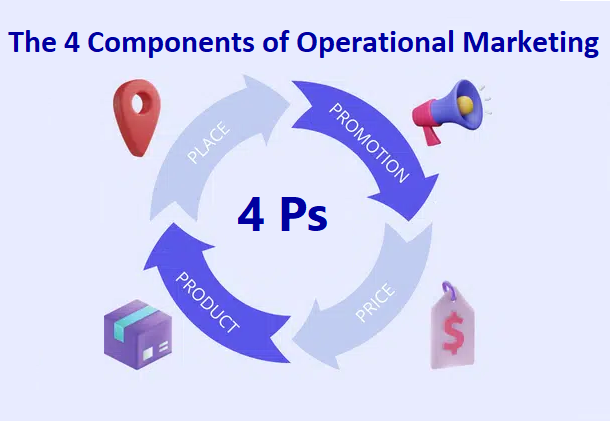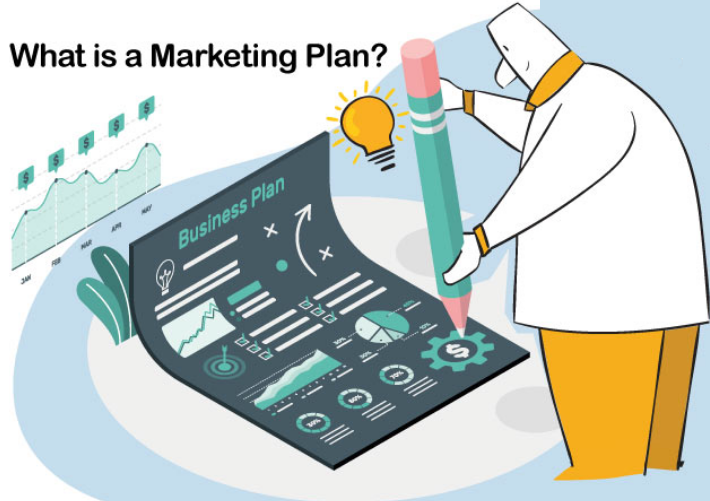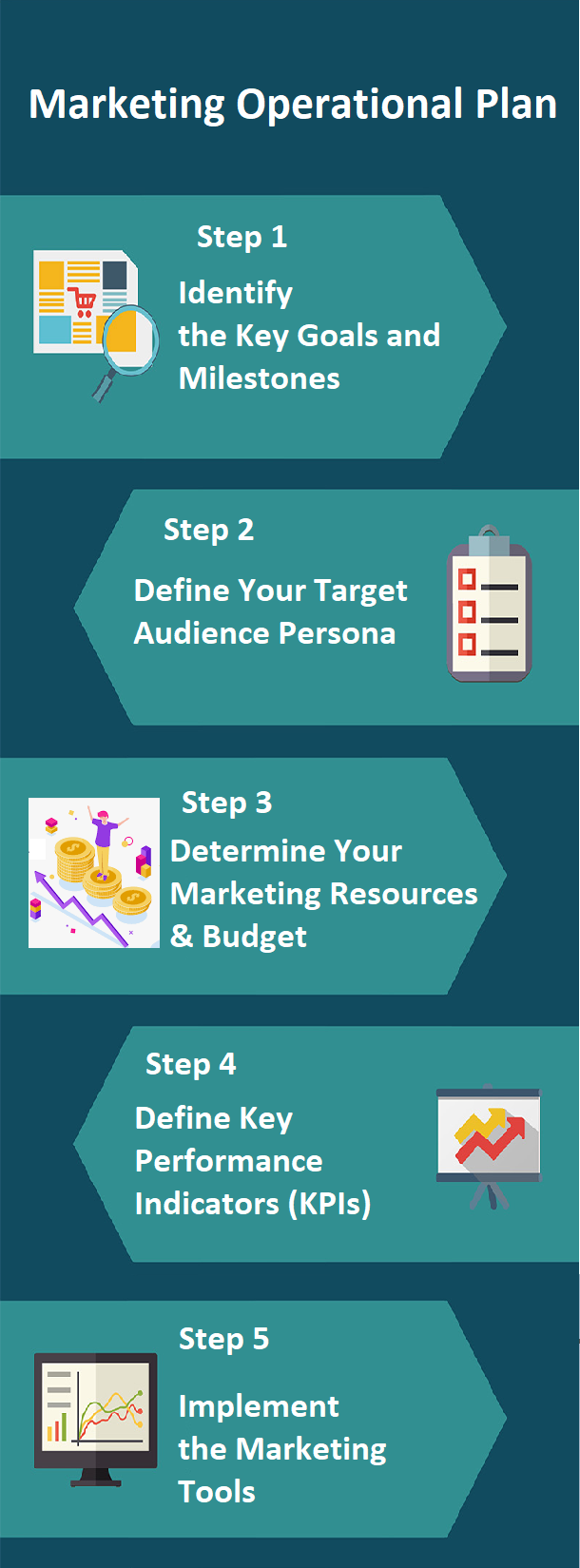One of the marketing methods is operational marketing, in which the percentage of success is very impressive due to the good partnership of others. Therefore, in this article, we’re going to walk through the operational marketing plan.
An operational marketing plan outlines the specific actions and tactics that an organization will undertake to achieve its marketing objectives. It includes details on the marketing activities, timelines, budgets, and resources required to implement the plan effectively and drive desired results.
What are the 4 components of operational marketing?
The importance of operational marketing due to its effectiveness, which makes the implementation of marketing activities much smoother, is not hidden from anyone. Several key elements are required to run a successful operational marketing plan and its excellence. Do you know the answer to this question: what are the 4 components of operational marketing?
But before anything, we need to examine the concept of operational marketing at a high level.
So let’s get started.
The meaning of operational marketing
In the market world and based on the marketing of products or services in sales, two types of marketing have been defined that complement each other: Strategic marketing and operational marketing.

The concept of operational marketing seeks to determine the ways and strategies to increase the company’s productivity and profitability through marketing activities.
In fact, operational marketing matches all the marketing actions implemented in order to achieve the best results during the marketing strategy.
It is important to know that in this approach, environmental variables such as laws & regulations, ethical issues, social processes & environmental impacts, and other such matters are also examined.
However, with the help of the tools provided to organizations and companies in this way, senior managers are looking to measure the effectiveness of marketing activities.
This measurement is done with the aid of criteria such as market share, sales growth, customer churn rate, customer satisfaction, and quality of products or services.
To put it simply, operational marketing is a vital part that greatly affects the performance of companies and organizations.
A marketing leader in an organization or a company is like a leader or a police chief or a school principal who is responsible for guiding and training a group of individuals.
The 4 core components of operational marketing
There are 4 specific and key elements required to achieve true operational marketing excellence. Hence, when combined, marketing organizations can move much closer to their true potential.
However, it is natural that a missing component can destroy everything in the whole system.
All organizations and companies need to use the marketing mix to carry out their operations and focus their actions on the following 4 main areas:
- Product
- Place
- Promotion
- Price

More precisely, you can achieve your marketing and sales objectives with the help of these 4 elements above.
1. Product: This element involves all features related to products or services, including design, and how to use and apply, options, packaging, service, maintenance conditions, warranty, and return of products.
2. Place: This includes all strategies related to pricing and discounts, as well as payment methods.
3. Promotion: This element is related to the distribution of products in your target market, which can include distribution strategies, distribution channels, geographic coverage of products, etc.
4. Price: It is the main element in the marketing mix, which contains all communication and advertising strategies that include direct marketing, digital marketing, content marketing, communication channels, social media, etc.
In addition to the 4 key elements that determine operational marketing or the market mix, organizations, and systems all need to be familiar with the following factors and apply them in planning for operational marketing:
- The approach of objective-driven and strategy-based planning
- The view of a comprehensive marketing campaign plan
- The process of measuring, refining, and optimizing
- The relationship between all activities and meaningful results
What is the difference between marketing and operational plan?
If you want to know the difference between marketing and operational plan, you must first define marketing and operational plan and then discuss their differences.
What is a marketing plan?

A marketing plan is a strategic roadmap that businesses use to organize, implement, and track their marketing strategies over a specific period of time.
A marketing plan can include separate marketing strategies for different marketing and sales teams across the company, But they all work towards the same main business objectives.
The purpose of a marketing plan is to write down your tactics and strategies in an organized way and help you stay on track, think about each campaign’s mission, buyer personas, budget, tactics, etc., and measure the success of your campaigns.
What is an operational marketing plan?
Surveys indicate that the operational marketing method is somehow one of the most important steps and categories of marketing.
In this type of marketing, you, as a marketer or business owner, implement your strategies and look for answers.
Always remember that success in operational marketing without a marketing plan is an unattainable goal.
All successful businesses must proceed with a written plan and specific aims. Otherwise, they may sometimes achieve accidental success, but in the end, they have no choice but to fail.
Since today’s market is very dynamic and growing. Accordingly, the importance of having a marketing plan has increased.

Having a good operational marketing plan will help you focus on making your business attractive to your potential customers and increase the chances of a sustainable and profitable future.
On top of that, an operational marketing plan is a bridge between strategic marketing and marketing execution, helping you focus on your goals for your marketing strategy.
Marketing plan vs operational marketing plan

1. One of the main differences between the operational marketing plan and marketing plan is that the operational marketing plan focuses on short-term and medium-term actions, unlike the marketing plan whose purpose is long-term.
2. A marketing plan defines the overall strategy in a market and links customers, competitors, and what the organization is capable of achieving.
Whereas an operational marketing plan defines the marketing mix strategy that will be used in order to reach more profit in the market.
3. A marketing plan is created at the departmental level, a company, or a small organization level, while an operational marketing plan is covered in separate plans in larger companies or organizations.
4. The operational marketing plan is proposed at the level of executive management and deals with specific, limited, and objective goals.
But this is while the marketing plan is implemented at the high and macro level of the organization and determines the goals, outline, and mission of the organization.
How do you write a marketing operational plan template?
Why do you as a marketer and sales representative need a marketing operational plan template that works well?
This is because an operational plan template allows you to:
1. Coordinate your daily tasks and activities with specific goals and short and long-term time frames of your organization
2. Make creating an operational marketing plan easy and fast for you
3. Don’t miss important details of an operational marketing plan
4. Increase your marketing return on investment (ROI) significantly and grow your business
5. Consistently improve your marketing activities and build workflows
6. Lead the implementation of your key marketing tactics and strategies in the right direction.
Well, the good news is that we’ve provided a ready-made operational marketing plan template here for you to make the most of, which you can apply as a great roadmap to start your own operational marketing plan.
So stay with us.
To write a great marketing operational plan, you should follow these 5 main steps:

Step 1: Determine the key goals and milestones of your business from marketing operation:
It is important to know that without properly defining the goals of your marketing plan, you will not be able to measure the success and progress of your business effectively.
Given that a good operational marketing plan and strategy will always have a defined vision, framework, and goals for your business, try to identify them as soon as possible.
This vision of your business and a clear view of the future will definitely allow you to design the right path for your marketing campaigns.
In addition to what has been said, knowing the goals and vision of your business can help you in the following cases:
1. Meeting the audience’s needs
2. Managing your website traffic
3. Providing new sales opportunities
4. Getting audience insights to create a marketing strategy
5. Developing and discovering your business marketing strategy compared to competitors
6. Designing to measure your growth and progress
Generally speaking, when you want to identify your business goals, you should define them under a standard format so that they have the following 5 main characteristics:
- Specific
- Measurable
- Accessible
- Realistic
- Timed-bound
It is interesting to know that this model, which consists of several logical components, is called a SMART model.
Step 2: Define your target audience persona:
Even if you are a professional in your business, in the stages of prospecting, sales funnel, and the process of converting audiences into sales opportunities and finally becoming a regular customer, you may face challenges.
But with the development of your business, the range of your audience and the processes of converting them into customers will increase, and one solution is not the answer to all sales channels.
This is where you need to define the persona of your audience.
In order to reach your goals in operational marketing and after identifying the objectives and vision of your marketing plan, you should define the persona of your target audience as soon as possible.
It is worth mentioning that buyer personas are hypothetical profiles of your ideal customers based on your demographic data, online behavior, and assumptions defined based on your experience or your competitors.
Anyway, demographic information such as gender, age, job title, education, location, family, interests, etc. is one of the basic elements of defining an audience persona.
In defining your audience persona, you must consider the following:
- Prospects’ target goals
- How to make decisions
- Challenges
- Social interactions
- Prospects’ purchasing behavior, etc.
Of course, depending on the type and goals of your business, you can go deeper in defining the persona of your audience.
It is very important to remember that not everyone in the community can be your audience. Every business, even if it is small, has a targeted audience for itself.
Based on this, you can change your audience’s buying behavior for the benefit of your business with detailed and targeted planning.
It is interesting to know that the first step in creating your customer personas is brainstorming.
After listing your complete contact personas, identify people who have similar needs or roles.
Finally, prioritize your list of contact personas by considering their influence on the final purchase decision, their relationship to your company, and the number of your audiences.
The good news is that you can get the most of their social media pages to capture the personas of your target audience. For example, you can take a look at their LinkedIn profile to find your contacts’ details easily.
Step 3: Determine your marketing resources and budget
Another factor you need to consider when preparing a marketing plan is the marketing budget and costs.
Marketing costs are very important. They include all of the expenses that a company or an organization incurs for selling, promoting, developing, and marketing its brand.
We all know brands that have done a lot of promotions at the beginning of their business and suddenly disappeared.
Most of these companies have faced problems in calculating the cost and how to cover this cost.
When developing a good operational marketing plan, you should be able to determine the number of marketing costs and how to finance them.
As a rule of thumb, keep in mind that you can allocate between 6% and 12% of your business’s gross revenue as your marketing expenses.
Of course, it is worthwhile to remember that you can recognize other personalized strategies for your business according to the amount of profit, business goals, the volume of campaigns, and other things.
Furthermore, to accurately budget for the start of an operational marketing program, you need to have all the events in a calendar so that you can budget for the required expenses in the business.
Step 4: Define key performance indicators (KPIs):
It is important to know that any good marketing plan will explain how it can accomplish its mission. And to measure and monitor its performance, you need to determine your KPIs.
KPIs are individual metrics that measure different marketing campaign elements and help you set short-term goals in your mission and inform managers of your progress.
This step of the operational marketing planning process is one of the most challenging and significant.
That’s why by measuring performance, you can improve service quality, reduce costs, and make accurate calculations for the marketing plan progress.
Besides, defining key performance measures helps organizations ensure that resources are spent on worthwhile activities.
Hot tip: You can accurately measure the success of your marketing operations using KPIs.
Here are some examples of marketing KPIs you can rely on to measure the effectiveness of your marketing operations:
- Cost per lead
- Revenue per employee
- Marketing output
- Marketing ROI
- Website views
- LinkedIn CTR
- Conversion rate
Let us explain KPIs to you with an example:
If your mission in the operational marketing plan is how to attract potential customers, you may want to measure the number of views to LinkedIn company pages and measure the amount of your LinkedIn posts’ organic views.
In this case, organic traffic is a KPI and you can boost their number over time.
Step 5: Implement the marketing tools required to start your operational marketing:
Now is the time to start all the necessary software, channels, and tools to help the marketing process.
Depending on the interests and habits of your customers, some marketing tools may be more effective than others.
It is up to you to choose the most appropriate and efficient tool for your marketing goals. There may be several.
Here are some examples of marketing tools that companies and organizations use to perform and improve their marketing activities:
- Google Adwords
- Google Analytics
- LinkedIn Analytics tool
- Google Ads
- Chrome Extension
- LinkedIn Sales Navigator
- Data visualization software
- LinkedIn profile URL CUFinder
What is an operational strategy example?
That being said, if you are looking to effectively plan for business success and reach your goals, you can use great operational strategies to improve resource management and competitive advantage.
Operational strategy is a guiding principle that is used to plan, analyze, and apply the operational marketing of an organization or a company.
Many businesses across industries take advantage of a variety of operational strategies to identify and implement cost-effective processes for distributing and promoting their products and services.
Here are several common examples of operational strategies that help businesses grow
1. Corporate strategy
2. Client-based strategy
3. Competitive strategy
4. Market absorption strategy
5. Supply chain strategy
6. Development oriented strategy
7. Cost-based strategies
8. Competency-based strategy
Examples of a corporate strategy:
Corporate strategy is the most important and key strategy for any business. This is because it includes the goals, mission, resources, vision of the company, and other things.
In order to improve innovation, deliver value to buyers, motivate employees, and attract investors, this strategy leverages portfolio & development strategies, corporate policies, and long-term objectives.
You can imagine an example of an operational plan for a software company.
The company aims to provide marketing strategies to increase its presence on LinkedIn, the largest professional networking platform.
And on this basis, this company will increase the number of contacts and customers significantly.
Since most of the referrals come from well-known and professional social media, hence, the company tries its best to invest in this area.
The basis of the operational plan implemented by the mentioned company can include the following:
- Objectives: Attracting contacts and being active on LinkedIn social media
- Timing: Short-term period
- Required resources: Advertising budget, holding social media learning courses, holding webinars, etc.
- Duties: Planning for more interaction with contacts, increasing the company’s engagement with customers on LinkedIn groups, creating content on the LinkedIn publishing platform and sharing content through LinkedIn posts, etc.
Another example of an operational strategy is auto parts retailers trying to change their manufacturing strategies by outsourcing many of their products to an automated service center.
Related Questions & Answers
Operational marketing examples
Operational marketing refers to the day-to-day activities and tactics employed by businesses to promote their products or services and drive sales. Here are two examples of operational marketing:
- Email Marketing: A company sends out a targeted email campaign to its customer database, featuring personalized content and offers. The email includes a clear call-to-action, such as a discount code or a limited-time promotion, to encourage recipients to make a purchase. The company tracks the email open rates, click-through rates, and conversion rates to measure the effectiveness of the campaign and make necessary adjustments for future emails.
- Social Media Advertising: A clothing brand runs a paid advertising campaign on social media platforms like Facebook or Instagram. They carefully select their target audience based on demographics, interests, and behaviors to ensure the ads reach the right people. The ads feature eye-catching visuals, compelling copy, and a strong value proposition to attract attention and generate interest. The company monitors the ad performance, analyzes metrics such as impressions, click-through rates, and conversions, and optimizes the campaign based on the results.
These examples demonstrate how operational marketing involves executing specific marketing tactics and closely monitoring their performance to achieve desired outcomes, such as increasing brand visibility, generating leads, and driving sales.
Operational marketing vs strategic marketing
Operational marketing and strategic marketing are two different aspects of a company’s overall marketing efforts.
Operational marketing focuses on the day-to-day activities and tactics involved in executing marketing campaigns and activities. It involves implementing specific marketing initiatives, such as advertising, email marketing, social media campaigns, and sales promotions. Operational marketing is concerned with the immediate tasks and actions that aim to drive sales, generate leads, and increase brand visibility. It focuses on the short-term execution of marketing plans and is typically more tactical in nature.
On the other hand, strategic marketing is a broader, long-term approach that involves the development of overarching marketing strategies and plans. Strategic marketing is concerned with setting the company’s marketing goals, defining target markets, understanding customer needs and preferences, conducting market research, and analyzing competition. It involves making strategic decisions regarding product positioning, market segmentation, brand development, and market entry strategies. Strategic marketing provides the framework for operational marketing activities and guides the overall direction and focus of the company’s marketing efforts.
In summary, operational marketing is the execution of specific marketing tactics and activities to achieve immediate goals, while strategic marketing involves the development of long-term strategies and plans to position the company in the marketplace and drive its overall marketing direction.
Levels of marketing plan strategic and tactical
A marketing plan consists of strategic and tactical levels, each playing a distinct role in achieving marketing objectives. Here are the levels of a marketing plan:
Strategic Level: This level focuses on long-term goals and overarching strategies. It includes:
- Market analysis and research
- Target market identification
- Competitive analysis
- Positioning and differentiation
- Marketing objectives setting
- Marketing mix development
- Branding and messaging strategies
- Market entry strategies
Tactical Level: This level involves the implementation of specific actions and initiatives to support the strategic goals. It includes:
- Advertising campaigns
- Content creation and distribution
- Social media marketing
- Search engine optimization (SEO)
- Public relations activities
- Sales promotions and discounts
- Event marketing
- Direct marketing initiatives
These levels work together in a marketing plan, with the strategic level providing the overall direction and framework, while the tactical level focuses on executing specific marketing tactics to achieve the desired outcomes.
Marketing plan steps
| Marketing Plan Steps |
|---|
| 1. Situation Analysis |
| 2. Define Marketing Objectives |
| 3. Conduct Market Research |
| 4. Identify Target Market |
| 5. Analyze Competition |
| 6. Develop Value Proposition |
| 7. Create Marketing Strategy |
| 8. Determine Marketing Tactics |
| 9. Allocate Marketing Budget |
| 10. Develop Action Plan |
| 11. Implement Marketing Initiatives |
| 12. Monitor and Evaluate Results |
| 13. Make Adjustments and Optimization |
| 14. Measure Return on Investment (ROI) |
These steps outline the key components of a comprehensive marketing plan. Starting with a thorough analysis of the current situation, the plan progresses through defining objectives, conducting research, identifying target markets, and analyzing the competition. Then, the focus shifts to developing a value proposition, creating a marketing strategy, determining tactics, and allocating the marketing budget. The plan is implemented through an action plan, and the results are monitored, evaluated, and adjusted as needed. Finally, measuring the return on investment (ROI) helps gauge the effectiveness of the marketing efforts.
Conclusion
Operational marketing means a series of structured actions that are carried out to achieve the required goals or in other words to get the objectives of a marketing plan. You can measure your marketing campaigns efficiently and effectively with an operational marketing plan.
A good operational marketing plan is essential for all companies and organizations, both small and large.
But since marketing plans are often not well thought out and rarely implemented properly over the duration of a marketing plan, there is a risk of your business failing.
Unless that operational marketing plan is created intelligently, thoughtfully, and in a completely professional manner. So that it can achieve all your goals and bring you an ROI.
FAQs
What is an operational plan template?
In addition to setting organizational goals and providing a framework for the organization’s tasks, an operational marketing plan template can create detailed outlines for efforts to engage employees, sales u0026amp; marketing teams, and other parts of the organization and company.
What is a good operational plan?
A good operational plan typically provides a clear and precise goal and framework for every organization or company, so that everyone from sales and marketing teams to employees is focused on achieving it.
What should an operational plan include?
An operational plan should include the following items: The clear and defined objectives and time frameworks, An overview of the executive summary, Continuous activities required to achieve goals, A process for monitoring and optimizing, Key performance indicators (KPIs) and quality standards, Resources and manpower requirements.
